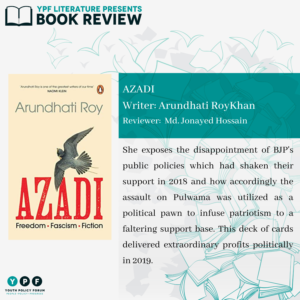The world & time we live in are unforgiving and unsettling. This time a year ago, on the off chance we were informed that ‘lockdown’ would be important for the day by day dictionary, odds are we may have frozen. Yet, for people in many parts of the world, a ‘lockdown’ is a perpetual experience. Just as the whole world went into lockdown due to Covid-19, Kashmir was emerging from one.

Arundhati Roy’s Azadi, a series of essays and texts of lectures delivered on freedom in a world of rising fascism documents the contemporary commentary of world events. She exposes the disappointment of BJP’s public policies which had shaken their support in 2018 and how accordingly the assault on Pulwama was utilized as a political pawn to infuse patriotism to a faltering support base. This deck of cards delivered extraordinary profits politically in 2019.
The pieces offer a solid autopsy of Prime Minister Narendra Modi and the diabolical organization of powers related to his regime. Composed as stories and are more abstract than what we typically find in different works of non-fiction.
She encapsulates more specifically the current despicable state of affairs in India and the ongoing establishment of an authoritarian and fascist regime under its current government, the 100-year-old dream of RSS, Muslim minority being regressed to second class citizen with the introduction of CAA & NRC and Dalits being targeted for not being subservient to the caste system.
The essay ‘In What Language Does Rain Fall Over Tormented Cities?’ forms novel composition as a craft of interpretation. While portraying the narrative of the division of Hindi and Urdu, it shows how her books are written in one language yet envisioned in several languages.
Another essay, ‘The Graveyard Talks Back’, skilfully weaves the creation of her writing and political analysis, considering fiction in the hour of fake news.
Of everything, my favourites are, One, her rant on what she sees as the ridiculousness of a “Doctrine of One Nation, One Language, One Religion, One Constitution” being forced on a region e that is “not a country”, but rather a “continent that is more complex and diverse. A continent with 780 languages, last time anyone checked, barring lingos which is more than the entirety of Europe. On the other hand, Roy’s composition is in defense of multiplicity. The India she wants us to grasp is a vast ocean, a fragile and peevish social ecosystem.
Two, what she portrays as “Divert-Attention-and-Conquer” that transitioned from the classic “Divide-and-Conquer” and how media facilitates this. It resembles an incline where stories come and stories go and we longer realize where to assign our time, consideration, and concern most.
Also, the political force of words and languages reverberates well.
If we have followed the news at least once a week, Roy’s stories won’t treat us with new realities and bits of knowledge. They offer substantial stuff to readers from different corners of the world. Yet at the same time, I treasure her work as she stands up for the helpless, gives them ground, and brings us into the whirlpool of vulnerability.
This book serves fine as a narrative exposition of her ‘’The Ministry of Utmost Happiness”. Although it lacks de facto evidence it is a good read, nonetheless.